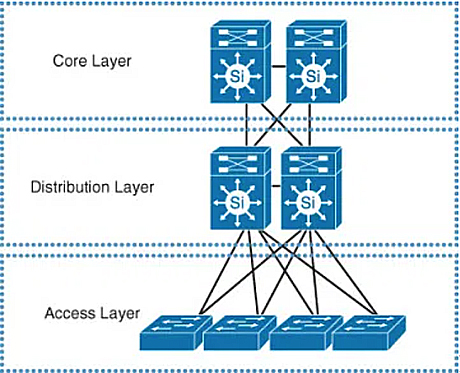The CityU Campus Network has gone through several rounds of technology refreshment, dynamically evolving together with CityU campus development, leveraging the latest advanced technology to provide seamless and reliable data services to all students and staff in CityU.
Some key characteristics are:
The design principle of the CityU Campus Network is to develop a single all-round high-speed data network, to provide different kinds of data services to all students and staff, including general network access (computers, smartphone and Wi-Fi access points), voice (IP phones, wireless phone), video (IP CCTV, video conference, AV equipment) and other smart-campus related initiatives (IoT Sensors).

The CityU Campus Network is built based on a 3-layers hierarchy architecture. Each layer on the hierarchy focuses on specific roles to ensure the overall efficiency of the campus network:
| Core layer: | Provides optimal high-speed data transport and routing between distribution layers |
| Distribution layer: | Extremely scalable layer, provides connectivity and access control between the access layers and core layers. |
| Access layer: | Provides network connectivity to users and end-point devices. Power-Over-Ethernet (PoE) technology has also been adopted in order to ease additional network devices attachment, e.g., Wi-Fi access points, IP Camera, IP Phones, IoT sensors, audio/video related network equipment, etc. |
The CityU Campus Network has a modular design that can well align with the growth of the CityU. Each building at CityU, e.g., Yeung Kin Man Academic Building (YEUNG), Li Dak Sum Yip Yio Chin Academic Building (LI), Lau Ming Wai Academic Building (LAU), and the new Jockey Club One Health Tower (JCT) etc., is served by a separate set of distribution layer equipment. This design provides flexibility in adding new building blocks quickly with minimal impact on other buildings. The modular design also facilitates resiliency via improved fault isolation.
Resilience is one of the significant consideration factors in the campus network design. Each network layer consists of at least two network switches located at different locations (Hub Rooms) for environmental resilience (e.g. power, air-conditioning, etc.). All network equipment is interconnected in a star topology with multiple network links, and the network cable between equipment uses different routing where possible to improve the path diversity. Each core or distribution layer network switch also has redundancy modules built within the equipment (e.g. power supplies and controlling engine) to improve their service availability.
Multi-layer of firewalls has been installed on the CityU Campus Network to protect against cyber-attacks. Advanced Threat Protection (ATP) has also been implemented to analyse traffic pattern, identify malicious activities and automate the related blocking instantly. To further enhance the protection to individual users, Software-Defined Access (SD-A) technology is in the roadmap of the campus network for granular security control.